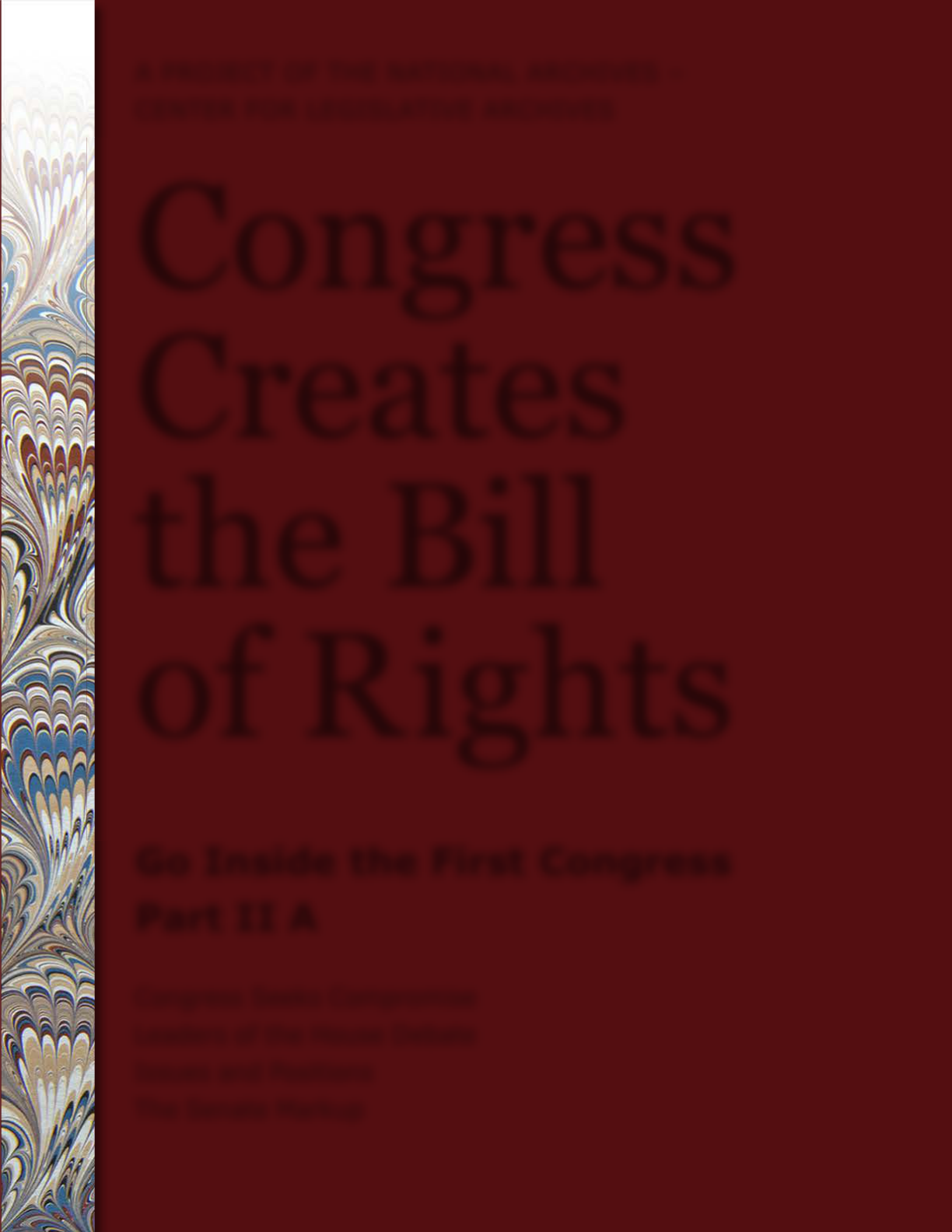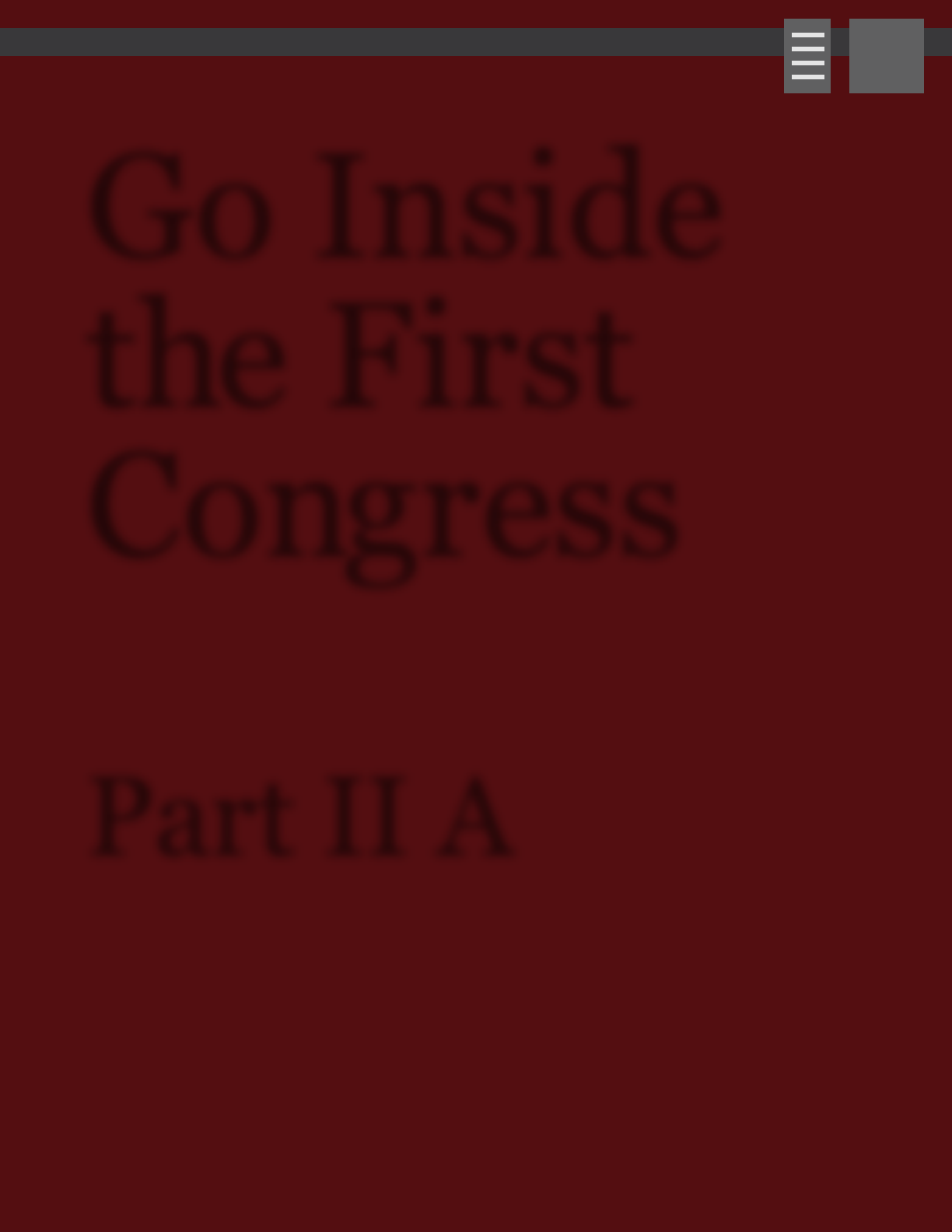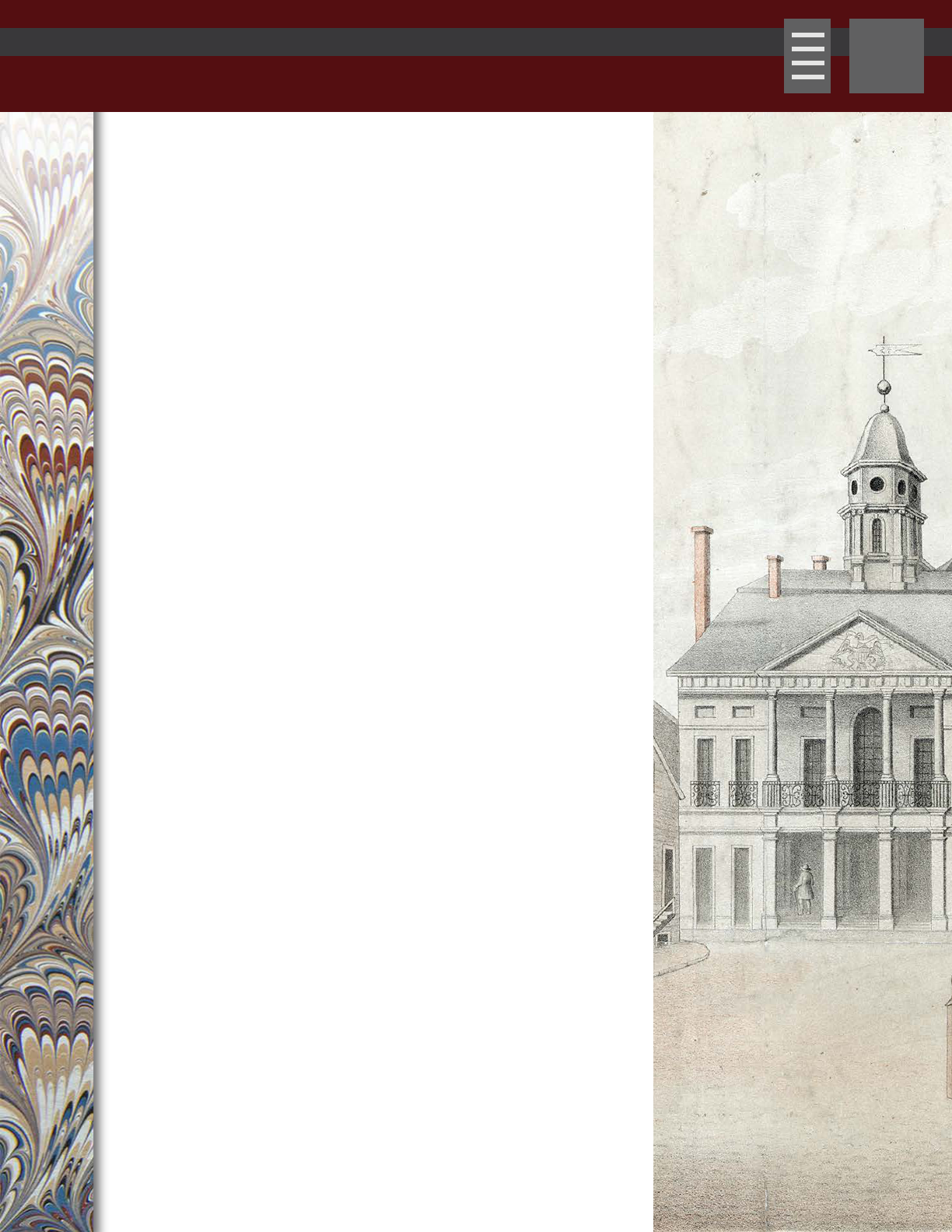
Congress Creates the Bill of Rights consists of
three elements: a mobile application for tablets,
an eBook, and online resources for teachers and
students on the Center for Legislative Archives
website (http://www.archives.gov/legislative/
resources/bill-of-rights.html). Each provides a
distinct way of exploring how the First Congress
proposed amendments to the Constitution in 1789.
This PDF contains all the content of the app
divided into four sections:
• Get the Background (Part I);
• Go Inside the First Congress (Part II A);
• Amendments in Process (Part II B); and
• Join the Debate and Appendix (Part III).
Each part is sized so that it can be easily down -
loaded or printed on a wide variety of devices.
Center for Legislative Archives
National Archives
National Archives Trust Fund Publication
Foundation for the National Archives
Funding provided by
The Chisholm Foundation
The Dyson Foundation
Humanities Texas
Designed and produced by Research & Design, Ltd.,
Arlington, Virginia
2
Congress Creates the Bill of Rights

3
Go Inside the First Congress
Title Page. . . . . . . . . . . . . . . . . . . . . . . . . . . . . . . . . . . . . . . . . . . . . . . . . . . . . . . . . . . . . . . . . . 1
Project Description . . . . . . . . . . . . . . . . . . . . . . . . . . . . . . . . . . . . . . . . . . . . . . . . . . . . . . . . . 2
Contents . . . . . . . . . . . . . . . . . . . . . . . . . . . . . . . . . . . . . . . . . . . . . . . . . . . . . . . . . . . . . . . . . . 3
Go Inside the First Congress (Part II A) . . . . . . . . . . . . . . . . . . . . . . . . . . 5
Congress Seeks Compromise . . . . . . . . . . . . . . . . . . . . . . . . . . . . . . . . . . . . . . . . . . . . . . . . . 6
Leaders of the House Debate . . . . . . . . . . . . . . . . . . . . . . . . . . . . . . . . . . . . . . . . . . . . . . . . . 7
The Champion of Amendments . . . . . . . . . . . . . . . . . . . . . . . . . . . . . . . . . . . . . . . . . 8
James Madison (1751–1836) Virginia . . . . . . . . . . . . . . . . . . . . . . . . . . . . . . 8
Federalist Position on Amendments . . . . . . . . . . . . . . . . . . . . . . . . . . . . . . . . . . . . . 9
Fisher Ames (1758–1808) Massachusetts. . . . . . . . . . . . . . . . . . . . . . . . . . 10
Roger Sherman (1721–1793) Connecticut . . . . . . . . . . . . . . . . . . . . . . . . . . 11
James Jackson (1757–1806) Georgia. . . . . . . . . . . . . . . . . . . . . . . . . . . . . . 12
Anti-Federalist Position on Amendments. . . . . . . . . . . . . . . . . . . . . . . . . . . . . . . . 13
Aedanus Burke (1743–1802) South Carolina . . . . . . . . . . . . . . . . . . . . . . . 14
Thomas Tudor Tucker (1745–1828) South Carolina . . . . . . . . . . . . . . . . . 15
Elbridge Gerry (1744–1814) Massachusetts . . . . . . . . . . . . . . . . . . . . . . . . 16
Issues and Positions. . . . . . . . . . . . . . . . . . . . . . . . . . . . . . . . . . . . . . . . . . . . . . . . . . . . . . . . 17
Should the Constitution be amended? . . . . . . . . . . . . . . . . . . . . . . . . . . . . . . . . . . 18
Should the House of Representatives have few or many members? . . . . . . . . . . 19
Should the people have the authority to instruct representatives? . . . . . . . . . . . 20
Should the federal Bill of Rights apply to the states?. . . . . . . . . . . . . . . . . . . . . . . 21
Should the federal taxation power be further limited? . . . . . . . . . . . . . . . . . . . . . 22

4
The Senate Markup . . . . . . . . . . . . . . . . . . . . . . . . . . . . . . . . . . . . . . . . . . . . . . . . . . . . . . . . 23
Close-up on Compromise . . . . . . . . . . . . . . . . . . . . . . . . . . . . . . . . . . . . . . . . . . . . . . . . . . . 28
August 24, 1789 . . . . . . . . . . . . . . . . . . . . . . . . . . . . . . . . . . . . . . . . . . . . . . . . . . . . . 29
September 3, 1789 . . . . . . . . . . . . . . . . . . . . . . . . . . . . . . . . . . . . . . . . . . . . . . . . . . . 30
September 3, 1789 . . . . . . . . . . . . . . . . . . . . . . . . . . . . . . . . . . . . . . . . . . . . . . . . . . . 31
September 4, 1789 . . . . . . . . . . . . . . . . . . . . . . . . . . . . . . . . . . . . . . . . . . . . . . . . . . . 32
September 9, 1789 . . . . . . . . . . . . . . . . . . . . . . . . . . . . . . . . . . . . . . . . . . . . . . . . . . . 33
September 14, 1789 . . . . . . . . . . . . . . . . . . . . . . . . . . . . . . . . . . . . . . . . . . . . . . . . . . 34
September 24, 1789 . . . . . . . . . . . . . . . . . . . . . . . . . . . . . . . . . . . . . . . . . . . . . . . . . . 35
October 2, 1789 . . . . . . . . . . . . . . . . . . . . . . . . . . . . . . . . . . . . . . . . . . . . . . . . . . . . . 36
Get the Background

6
The struggle over the Bill of Rights was one of many contested issues in the First Congress.
Through compromise, the House and Senate demonstrated that the Constitution could be
safely amended to protect the basic rights of citizens and correct perceived defects.
A fundamental divide existed between Federalists and Anti-Federalists on the question of
amendments to the Constitution. Yet, James Madison found areas of common ground to build
support for a set of amendments. He displayed his political genius by focusing on proposals
that could win the support of a two-thirds majority in each house of Congress, and ratification
by three-quarters of the states. Madison embraced the need to change the new charter in order
to keep the majority of its provisions intact, and he skillfully used the self-correcting measures
in Article V of the Constitution to amend it.
Article V sets a high bar and defines a unique process to propose and ratify amendments.
These requirements include congressional passage by two-thirds majorities in both houses.
Yet within the House and the Senate, and between those two chambers, many of the proce-
dures, tactics, and tools remain the same as the normal legislative process for moving
bills through the chambers to enact laws. This hard work of compromise between the House
and the Senate is revealed in a compelling document, the Senate Revisions to the House Pro-
posed Amendments to the U.S. Constitution (referred to as the Senate Mark-up).
The Founders saw Congress as the forum where representatives of the people and of the states
would reach decisions through deliberation and debate on issues of national importance. With
Madison’s able guidance, the First Congress was able to reconcile differences and set in motion
the ratification of the Bill of Rights.
Go Inside the First Congress

7
Go Inside the First Congress
The House of Representatives debated the Bill of Rights between June 8 and September 24,
1789, when the House voted on its final version of amendments. House debate was shaped by
the extreme reluctance, if not the open hostility, of the members towards Madison’s version of
amendments. Despite this opposition, Madison’s determination and skill guided the
amendments to House approval by a two-thirds vote.
The Champion
of Amendments
James Madison
Virginia
Anti-Federalist Position
on Amendments
Aedanus Burke
South Carolina
Thomas Tudor Tucker
South Carolina
Elbridge Gerry
Massachusetts
Federalist Position
on Amendments
Roger Sherman
Connecticut
James Jackson
Georgia
Fisher Ames
Massachusetts
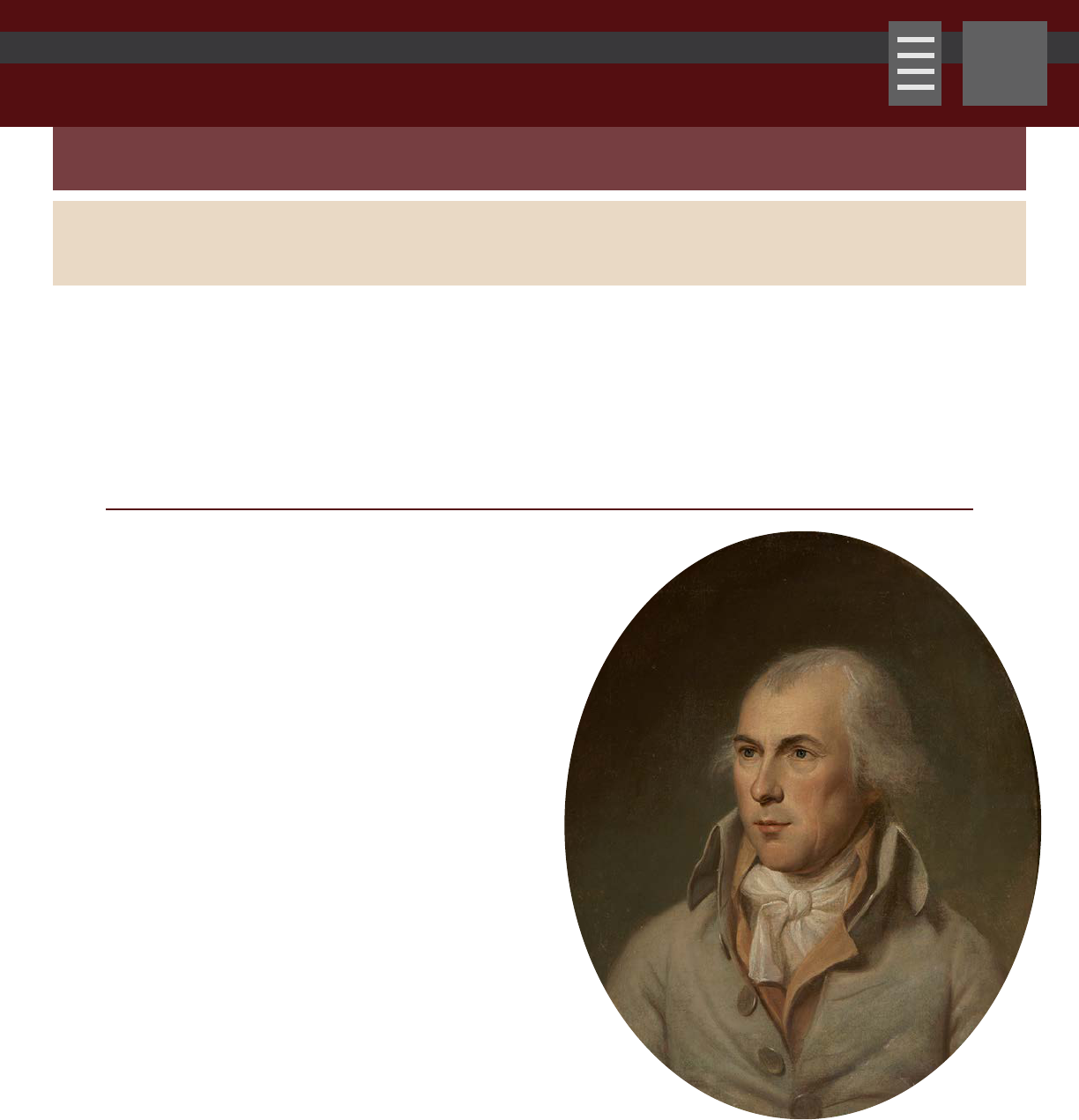
8
The Champion of Amendments
Go Inside the First Congress
James Madison played a critical role as instigator of the discussion on amendments, which
many members wished to avoid. He put together a carefully crafted, lawyerly speech that
called on the House to “expressly declare the great rights of mankind secured under this
Constitution.”
Born in Virginia, James Madison trained as a
lawyer at Princeton before settling in Orange
County, Virginia. He represented the county
in Virginia’s revolutionary and legislative
bodies. He also represented Virginia in the
Confederation Congress and at the Federal
Convention. He promoted ratification of the
Constitution in the press and as a delegate to
the state convention. Madison was the
author of the constitutional amendments
considered by the House, and the floor
leader who directed their passage. He
believed that by passing his version of
amendments, he could satisfy the public call
to protect rights without endangering the
Constitution and weakening the federal
government.
James Madison by Charles Willson Peale
Gilcrease Museum, Tulsa, Oklahoma

9
Federalist Position on Amendments
When the first Congress convened, the Federalist-dominated House opposed amending
the Constitution. Federalists generally believed that a bill of rights was unnecessary in a
government of delegated powers. They were suspicious that the Anti-Federalists’ primary
motive was to undo critical provisions in the Constitution before the new government could be
put into effect.
As the session progressed, Federalists came to realize that Madison’s amendments
neither weakened the federal government nor prevented it from fulfilling its national
responsibilities. They voted for Madison’s amendments, but without much enthusiasm.
Joining Madison as leaders of the debate were Federalists Roger Sherman of Connecticut,
Fisher Ames of Massachusetts, and James Jackson of Georgia.
Go Inside the First Congress
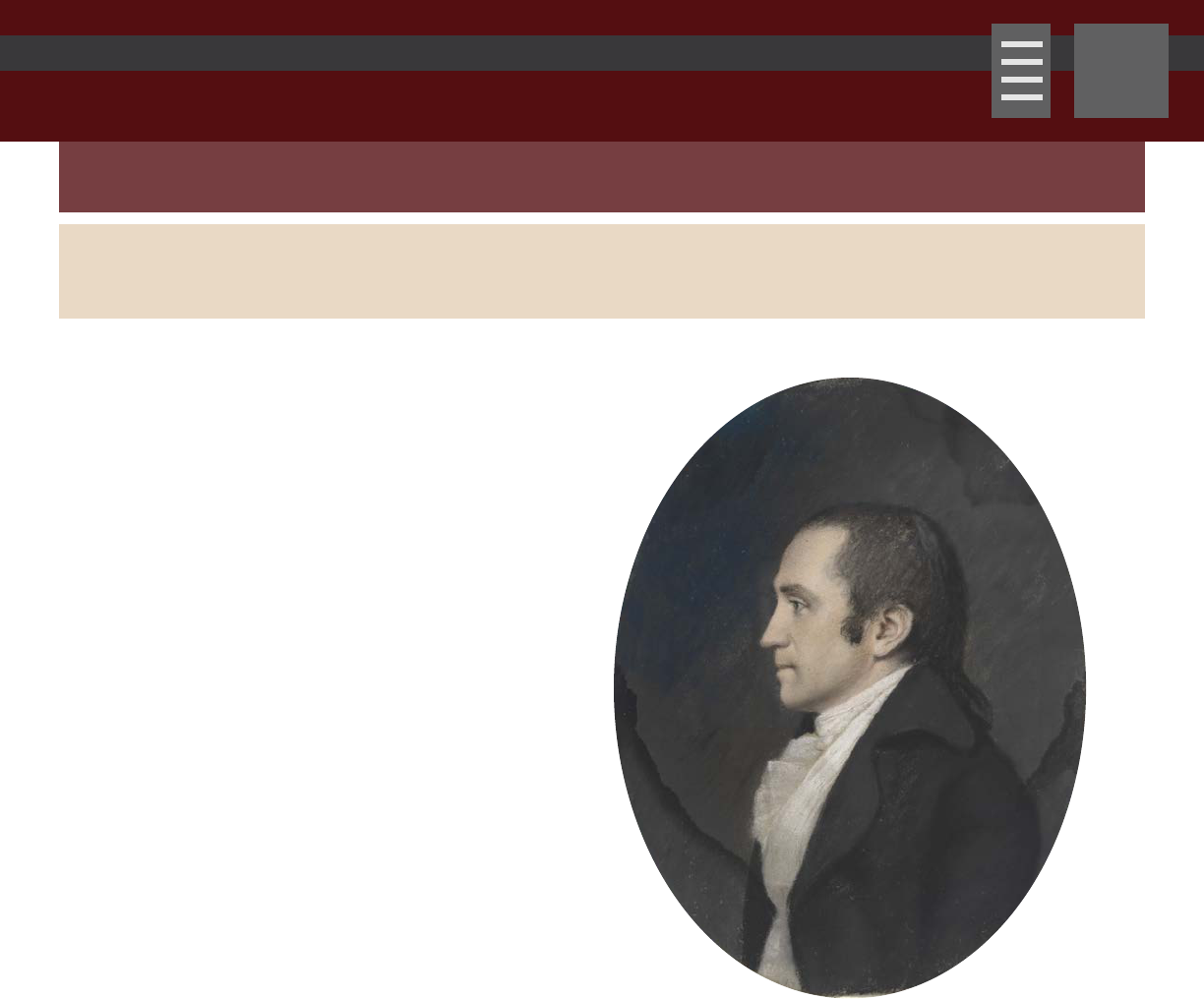
10
Federalist Position on Amendments
Go Inside the First Congress
Fisher Ames by James Sharples
National Portrait Gallery,
Smithsonian Institution/Art Resource, NY
Ames was a Harvard-educated lawyer from
Dedham, Massachusetts, who served in the
Massachusetts House of Representatives
before being elected as a Federalist to the
First Congress. As a member of the
Massachusetts convention, he ardently
supported ratification. He was opposed to
amending the Constitution, noting, “There
would be no limits to the time necessary to
discuss the subject … the session would not
be long enough.”
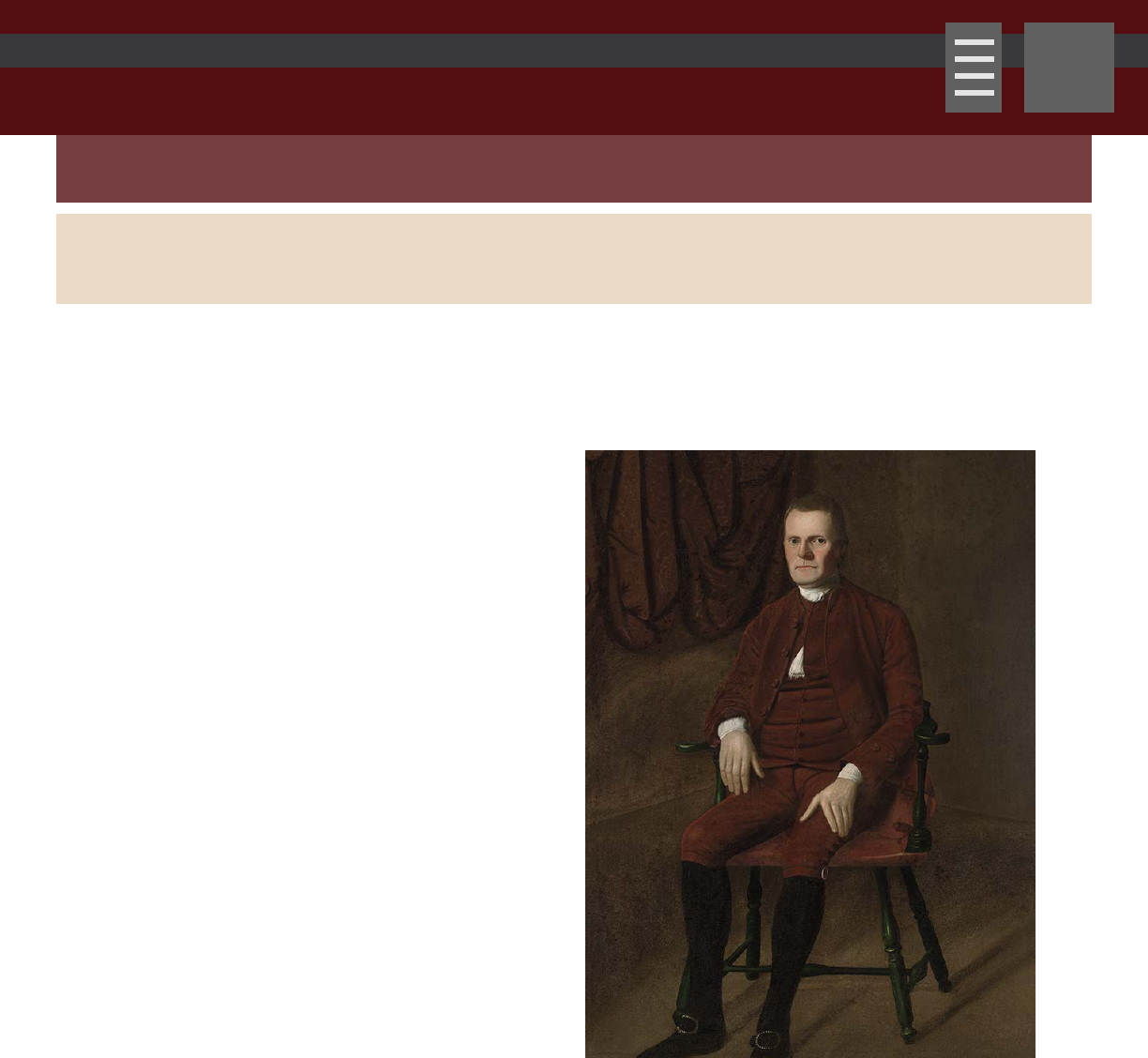
11
Federalist Position on Amendments
Go Inside the First Congress
Roger Sherman by Ralph Earl
Yale University Art Gallery
Born in Massachusetts, Sherman settled in
New Haven, Connecticut, where he was a
publisher, lawyer, merchant, judge, and
municipal and state officeholder. Sherman
served for many years in both the
Continental Congress, where he signed the
Declaration of Independence, and the
Confederation Congress. He assumed an
important role at the Federal Convention
and actively supported ratification in both
the press and the state convention. Sherman
played a critical role in the history of the Bill
of Rights when he proposed that the
amendments be added to the end of the
Constitution rather than written into its text,
as Madison had proposed.
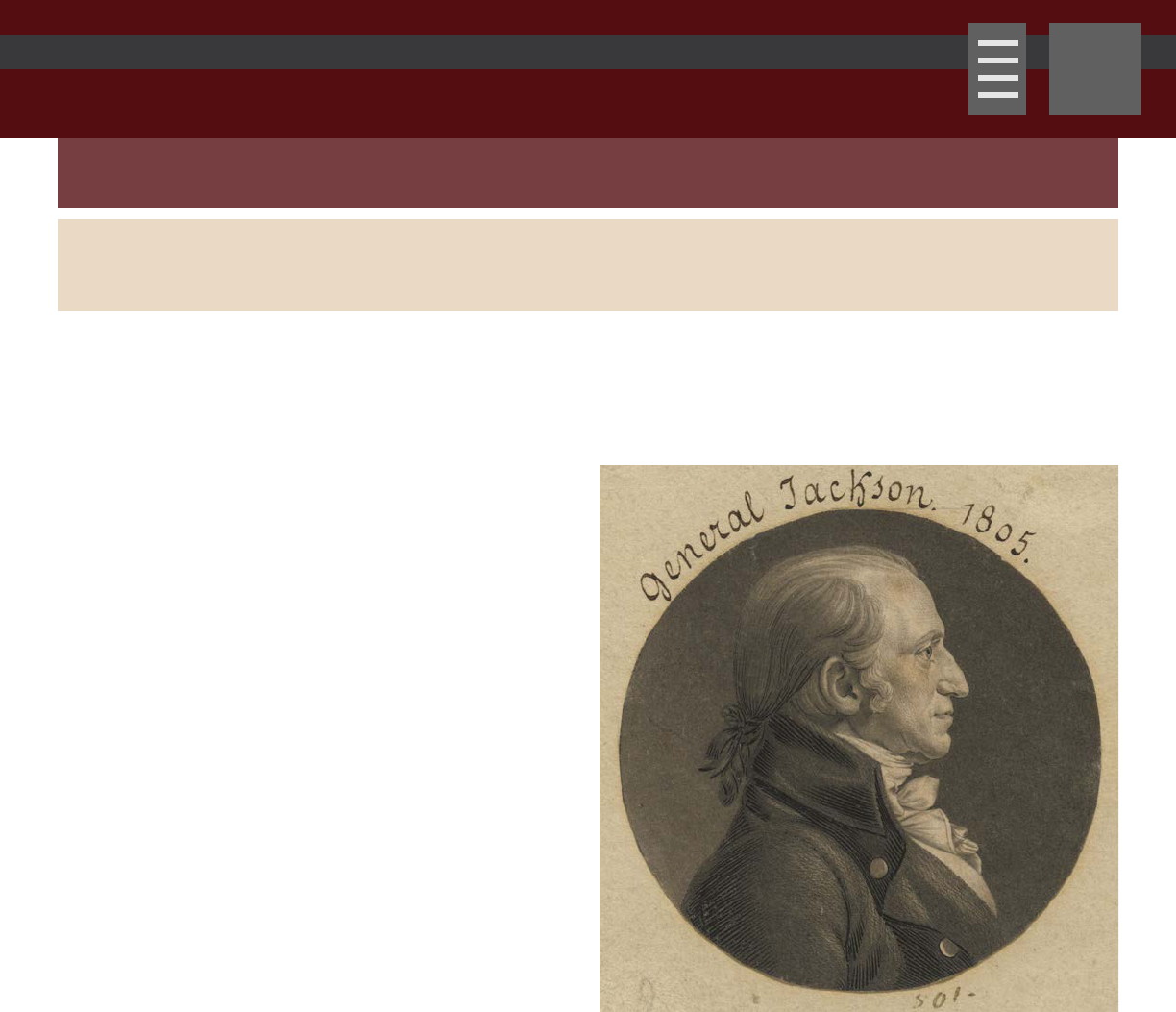
12
Federalist Position on Amendments
Go Inside the First Congress
James Jackson by Charles B.J. Févret de Saint-Mémin
National Portrait Gallery, Smithsonian Institution/Art Resource, NY
Born in England, James Jackson immigrated
to Savannah, Georgia, where he became a
planter and lawyer. He served in the state
assembly and was elected as a Federalist to
the First Congress. Jackson adamantly
opposed amending the Constitution,
remarking, “This is not the time for bringing
forward amendments.”

13
Anti-Federalist Position on Amendments
Go Inside the First Congress
Anti-Federalists wanted to add amendments to reduce the federal government’s powers.
These amendments took two forms: structural amendments that would transfer powers back
to the states, and rights-related amendments that would define fundamental freedoms
protected from federal government interference.
The Anti-Federalists proposed amendments designed to reduce Congress’s power to tax,
replace congressional control of federal elections with state control, eliminate the federal
court system, limit the powers of the president, and place restrictions on a standing army.
The Anti-Federalists believed that Madison had selected the least useful amendments from
those proposed by the states, and they consistently voted against his version of amendments.
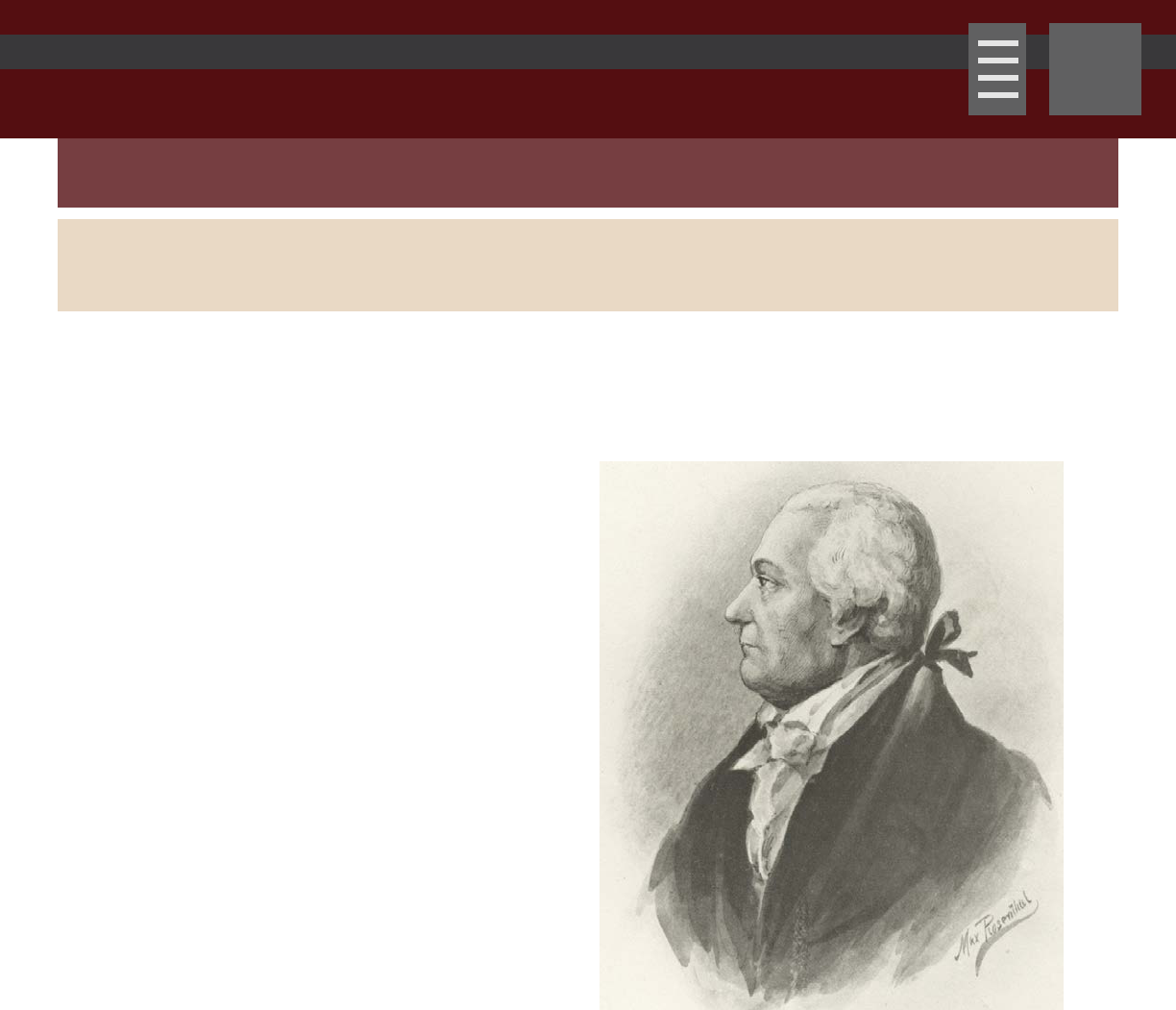
14
Anti-Federalist Position on Amendments
Go Inside the First Congress
Aedanus Burke by Max Rosenthal
Print Collection, Miriam and Ira D. Wallach Division of Art,
Prints and Photographs, The New York Public Library,
Astor, Lenox, and Tilden Foundations
Burke was born in Ireland and settled in
Charleston, South Carolina, where he served
as a judge in the state. He voted against
ratification in South Carolina’s convention.
An advocate of imposing strict limits on
federal power, Burke dismissed Madison’s
amendments as, “little better than whip-
syllabub, frothy and full of wind, formed only
to please the palate….”

15
Anti-Federalist Position on Amendments
Go Inside the First Congress
Born in Bermuda, Tucker settled in
Charleston, South Carolina. A lawyer, doctor,
and planter, he was a delegate to the state
legislature and, briefly, to the Confederation
Congress. Tudor was the proponent of
several amendments to limit federal power,
all of which were defeated in the House. He
captured the Anti-Federalist view of
Madison’s amendments when he complained
to a political ally, “You will find our
Amendments to the constitution calculated
merely to amuse, or rather to deceive.”
Thomas Tudor Tucker by Charles B.J. Févret de Saint-Mémin
National Portrait Gallery, Smithsonian Institution/
Art Resource, NY

16
Anti-Federalist Position on Amendments
Go Inside the First Congress
A merchant and office holder, Gerry was
born in Marblehead, Massachusetts. A
graduate of Harvard College, he later resided
in Cambridge, Massachusetts. Gerry
attended the Continental Congress, where he
signed the Declaration of Independence, and
he was also a member of the Confederation
Congress. A delegate to the Constitutional
Convention, he refused to sign the
Constitution and actively protested its
ratification at the Massachusetts state
convention, which he attended as an
unofficial observer. He was among the most
active participants in the House debate on
amendments and insisted that “all the
amendments proposed by the respective
states” should be considered, rather than
Madison’s limited set of proposals.
Elbridge Gerry by James Barton Longacre
National Portrait Gallery, Smithsonian Institution/
Art Resource, NY

17
These five questions represent the most contested issues raised in the debate over the
proposed amendments, and they best show the divide between the Federalists and the Anti-
Federalists. Many of the amendments proposed in Congress, especially those that touched
upon due process and other traditional rights, did not inspire discussion. These five triggered
the most debate, beginning with the simple question of whether the Constitution should be
amended at all.
Go Inside the First Congress
Should the Constitution be amended?
Should the House of Representatives have few or many members?
Should the people have the authority to instruct representatives?
Should the federal Bill of Rights apply to the states?
Should the federal taxation power be further limited?

18
Should the Constitution be amended?
Go Inside the First Congress
Federalist Position
“The more I consider the subject of
amendments, the more … I am convinced it
is improper .… I am against inserting a
declaration of rights in the constitution.…
If such an addition is not dangerous or
improper, it is at least unnecessary.…
Unless you except every right from the grant
of power, those omitted are inferred to be
resigned to the discretion of the
government.”
June 8, 1789
Anti-Federalist Position
“Many citizens expected that the
amendments proposed by the conventions
would be attended to by the House … and
several members conceived it to be their duty
to bring them forward.”
August 18, 1789

19
Should the House of Representatives
have few or many members?
Go Inside the First Congress
Federalist Position
“By enlarging the representation, we lessen
the chance of selecting men of the greatest
wisdom and abilities; because small district
elections may be conducted by intrigue; but
in large districts nothing but real dignity of
character can secure election.… Numerous
assemblies are supposed to be less under the
guidance of reason than smaller ones.”
August 14, 1789
Anti-Federalist Position
“Will that gentleman pretend to say we have
as much security in a few representatives as
in many? Certainly he will not. Not that I
would insist upon a burthensome
representation, but upon an adequate one …
[I am] in favor of extending the number to
two hundred …”
August 14, 1789
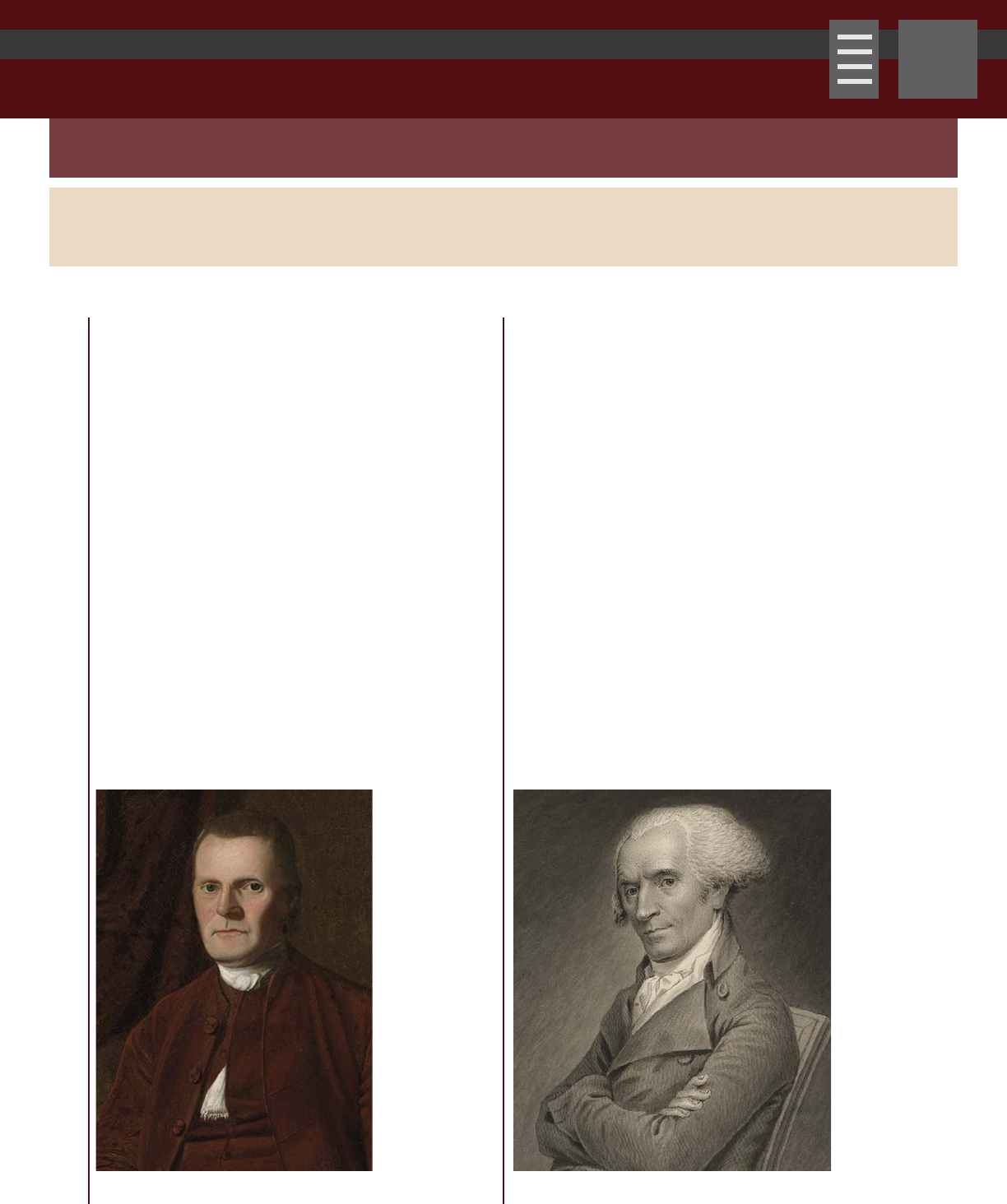
20
Should the people have the authority
to instruct representatives?
Go Inside the First Congress
Federalist Position
“Instructions cannot be considered as a
proper rule for a representative to form his
conduct by.… He is to consult the good of the
whole; Should instructions therefore
coincide with his ideas of the common good,
they would be unnecessary. If they were
contrary, he would be bound by every
principle of justice to disregard them.”
August 15, 1789
Anti-Federalist Position
“The power of instruction is in my opinion
essential to check an administration which
should be guilty of abuses.… To deny the
people this right is to arrogate to ourselves
more wisdom than the whole body of the
people possesses … our constituents have not
only a right to instruct, but to bind this
legislature.”
August 15, 1789

21
Should the federal Bill of Rights apply to the states?
Go Inside the First Congress
Federalist Position
“No state shall infringe the equal rights of
conscience, nor the freedom of speech, or of
the press, nor of the right of trial by jury in
criminal cases. [I] conceived this to be the
most valuable amendment on the whole list;
if there was any reason to restrain the
government of the United States from
infringing upon these essential rights, it was
equally necessary that they should be
secured against the state governments.”
August 17, 1789
Anti-Federalist Position
“It will be much better, I apprehend, to leave
the state governments to themselves, and not
to interfere with them more than we already
do, and that is thought by many to be rather
too much.”
August 17, 1789
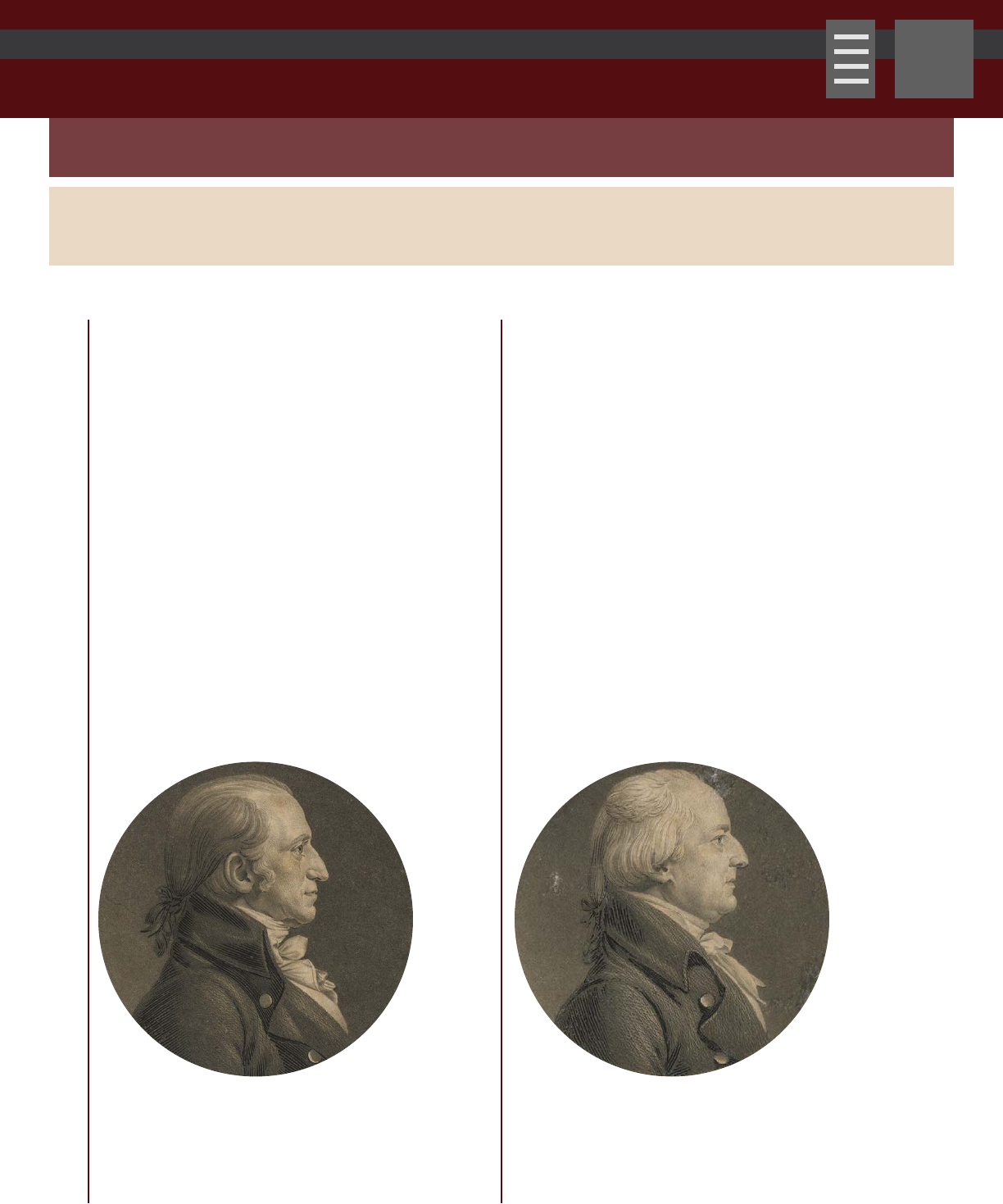
22
Should the federal taxation power be further limited?
Federalist Position
“I hope, sir, that the experience we have had
will be sufficient to prevent Congress ever
divesting themselves of [the taxing] power …
For if this power is taken from Congress, you
divest the United States of the means of
protecting the Union, or providing for the
existence and continuation of the
government.”
August 26, 1789
Anti-Federalist Position
“That Congress shall not exercise the power
of levying direct taxes, except in cases where
any of the states shall refuse, or neglect to
comply with their requisitions.”
August 26, 1789
Go Inside the First Congress

23
These four pages recorded on two sheets illustrate the process as seventeen House-proposed
amendments (referred to as “Articles”) were revised in the Senate. The brown ink markings,
made by the Secretary of the Senate, include cross-outs, combined amendments, and revised
language. They record the actions taken in the Senate between August 25 and September 9,
1789. After the Senate passage by a two-thirds vote, the Senate version of twelve amendments
was sent to the House for its consideration on September 14. The Bill of Rights was taking
shape, although final congressional passage would not occur until September 25.
Go Inside the First Congress

24
Senate Revisions to the House Proposed Amendments to the U.S. Constitution, 1789.
RG 46: Records of the U.S. Senate, National Archives
Go Inside the First Congress

25
Senate Revisions to the House Proposed Amendments to the U.S. Constitution, 1789.
RG 46: Records of the U.S. Senate, National Archives
Go Inside the First Congress
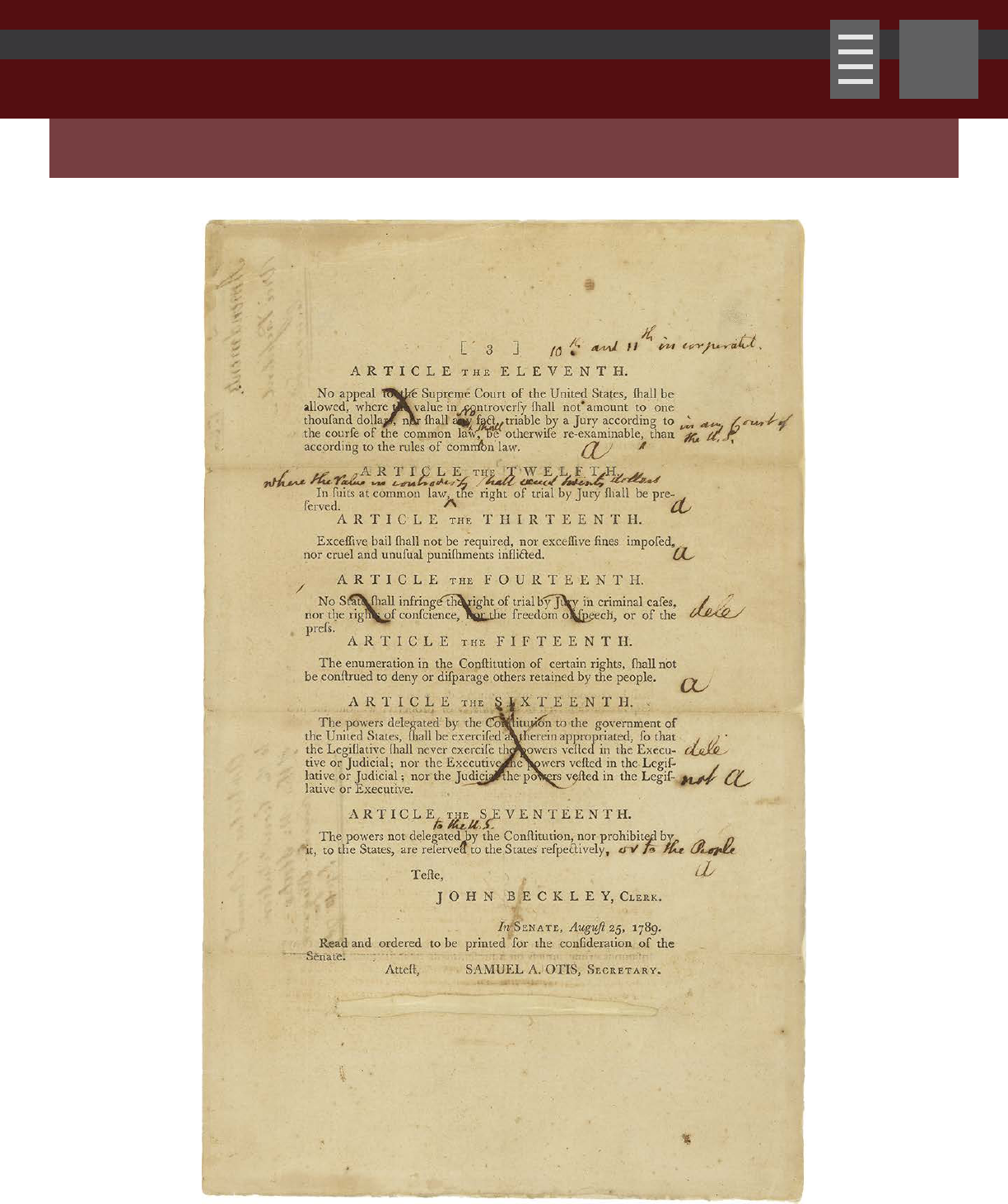
26
Senate Revisions to the House Proposed Amendments to the U.S. Constitution, 1789.
RG 46: Records of the U.S. Senate, National Archives
Go Inside the First Congress
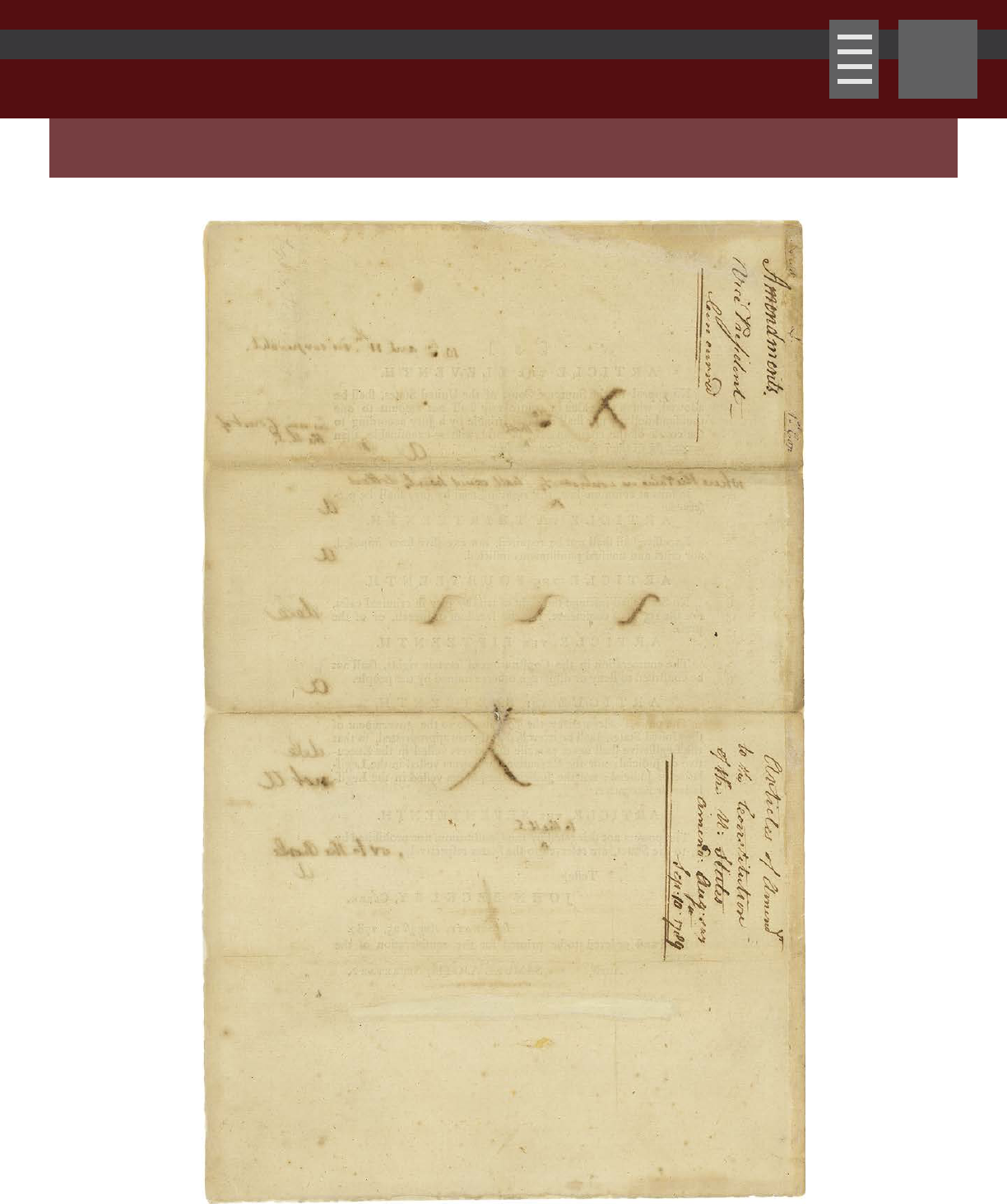
27
Senate Revisions to the House Proposed Amendments to the U.S. Constitution, 1789.
RG 46: Records of the U.S. Senate, National Archives
Go Inside the First Congress

28
The First Amendment of the Bill of Rights changed dramatically as it moved through the
House and the Senate in 1789. The First Amendment rights as we know them today were
originally defined in two separate House amendments: Article Three on protecting religious
rights, and Article Four on the rights of speech, press, assembly, and petition.
Though Senate debates were not recorded, Senate action on the amendments between August
25 and September 9 can be seen in the handwritten notations made on the printed version of
the proposed amendments passed by the House. The Senate spent a good deal of time and a
quantity of ink on Articles Three and Four, revising the language considerably. The Senate
decided to combine the two articles together, giving us a single amendment defining the
fundamental freedoms cherished by Americans in our founding era.
When the set of twelve amendments was sent to the states, the first two, Articles One
and Two, were not ratified. Article Three then rose to its preeminent place as the First
Amendment in the Bill of Rights.
This is a digital and conjectural re-creation, based on descriptions in the
Senate Legislative Journal and other sources, of step-by-step changes made
to Articles Three and Four of the proposed amendments passed by the House.
Go Inside the First Congress
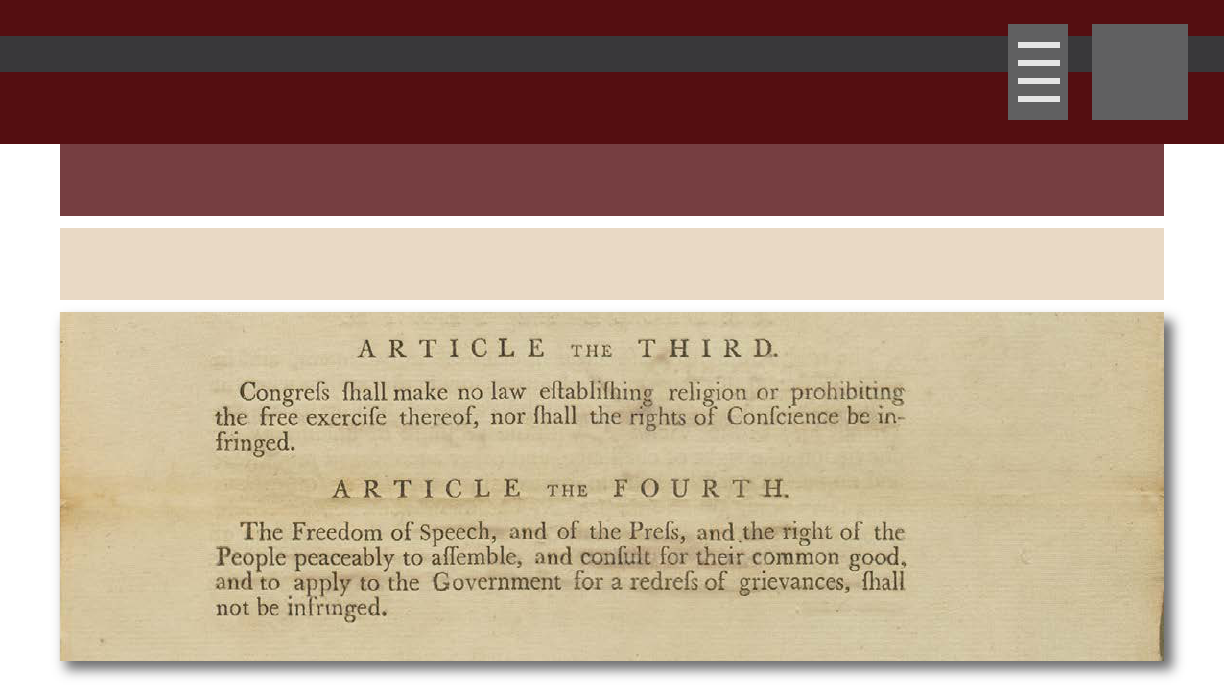
29
August 24, 1789
August 24, 1789
“Article the Third. Congress shall make no law establishing religion, or prohibiting the free exercise
thereof, nor shall the rights of Conscience be infringed.
Article the Fourth. The Freedom of Speech, and of the Press, and the right of the People peaceably to
assemble, and consult for their common good, and to apply to the Government for redress of
grievances, shall not be infringed.”
Senate Revisions to the House Proposed Amendments to the U.S. Constitution, 1789.
RG 46: Records of the U.S. Senate, National Archives
Go Inside the First Congress
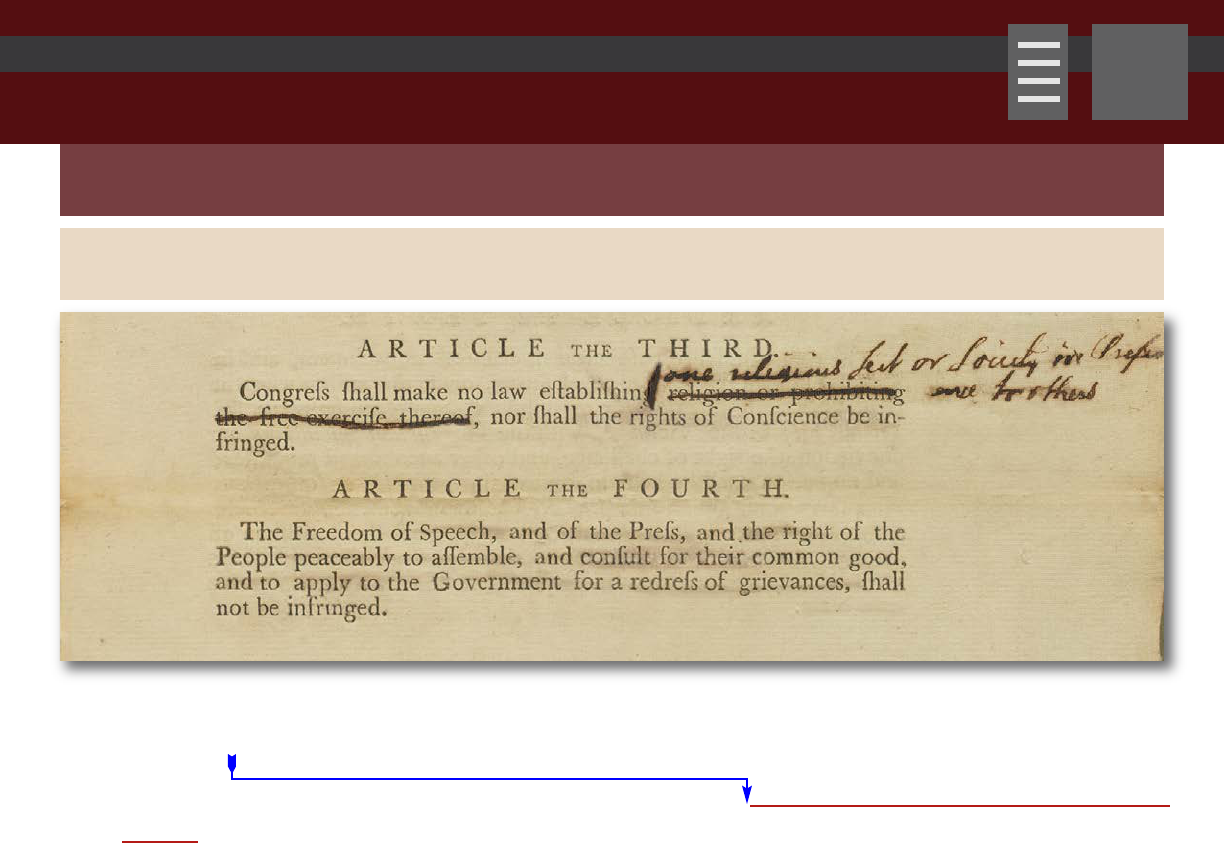
30
September 3, 1789
Senate Legislative Journal, September 3, 1789
Senate Revisions to the House Proposed Amendments to the U.S. Constitution, 1789.
RG 46: Records of the U.S. Senate, National Archives
“Article the Third. Congress shall make no law establishing religion, or prohibiting the free exercise
thereof, nor shall the rights of Conscience be infringed.
Article the Fourth. The Freedom of Speech, and of the Press, and the right of the People peaceably to
assemble, and consult for their common good, and to apply to the Government for redress of
grievances, shall not be infringed.”
Go Inside the First Congress
one religious Sect or Society in Preference to others
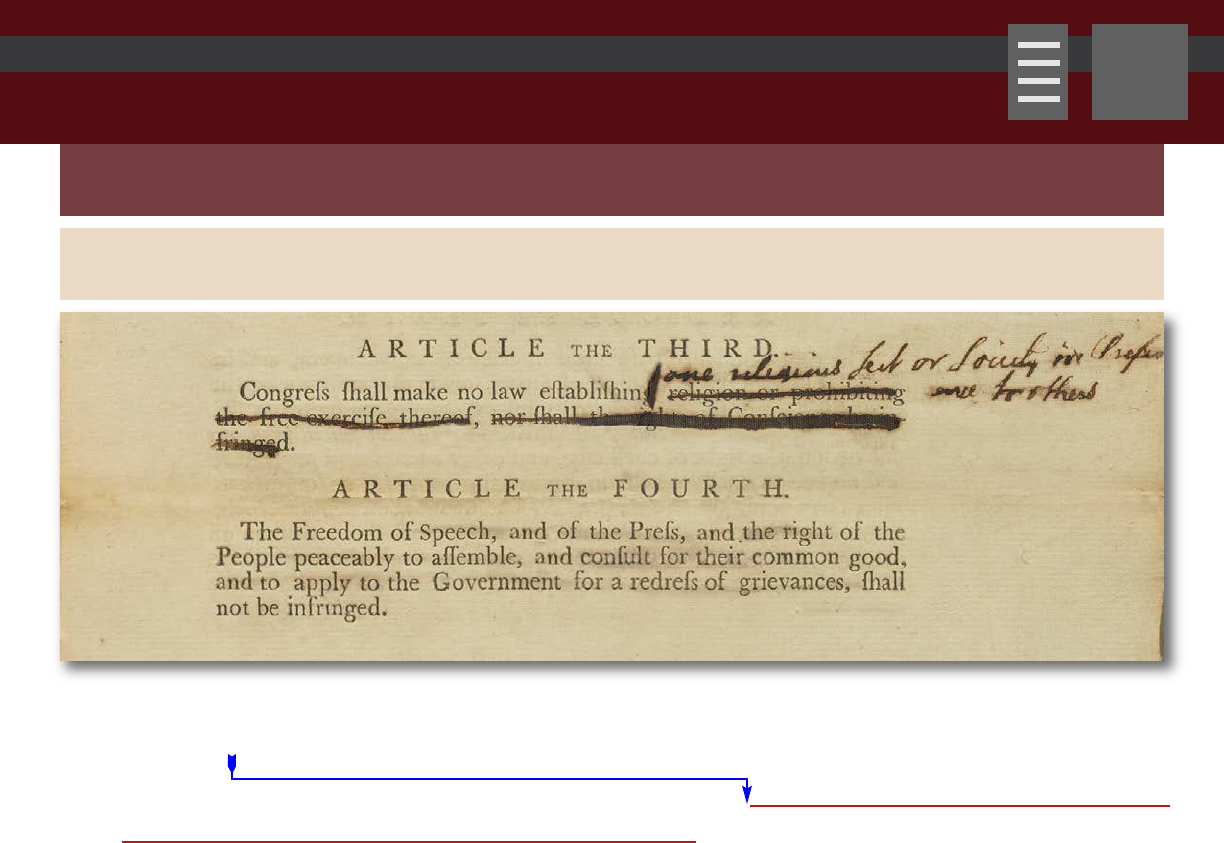
31
September 3, 1789
Senate Legislative Journal, September 3, 1789
Senate Revisions to the House Proposed Amendments to the U.S. Constitution, 1789.
RG 46: Records of the U.S. Senate, National Archives
“Article the Third. Congress shall make no law establishing religion, or prohibiting the free exercise
thereof, nor shall the rights of Conscience be infringed.
Article the Fourth. The Freedom of Speech, and of the Press, and the right of the People peaceably to
assemble, and consult for their common good, and to apply to the Government for redress of
grievances, shall not be infringed.”
Go Inside the First Congress
one religious Sect or Society in Preference to others
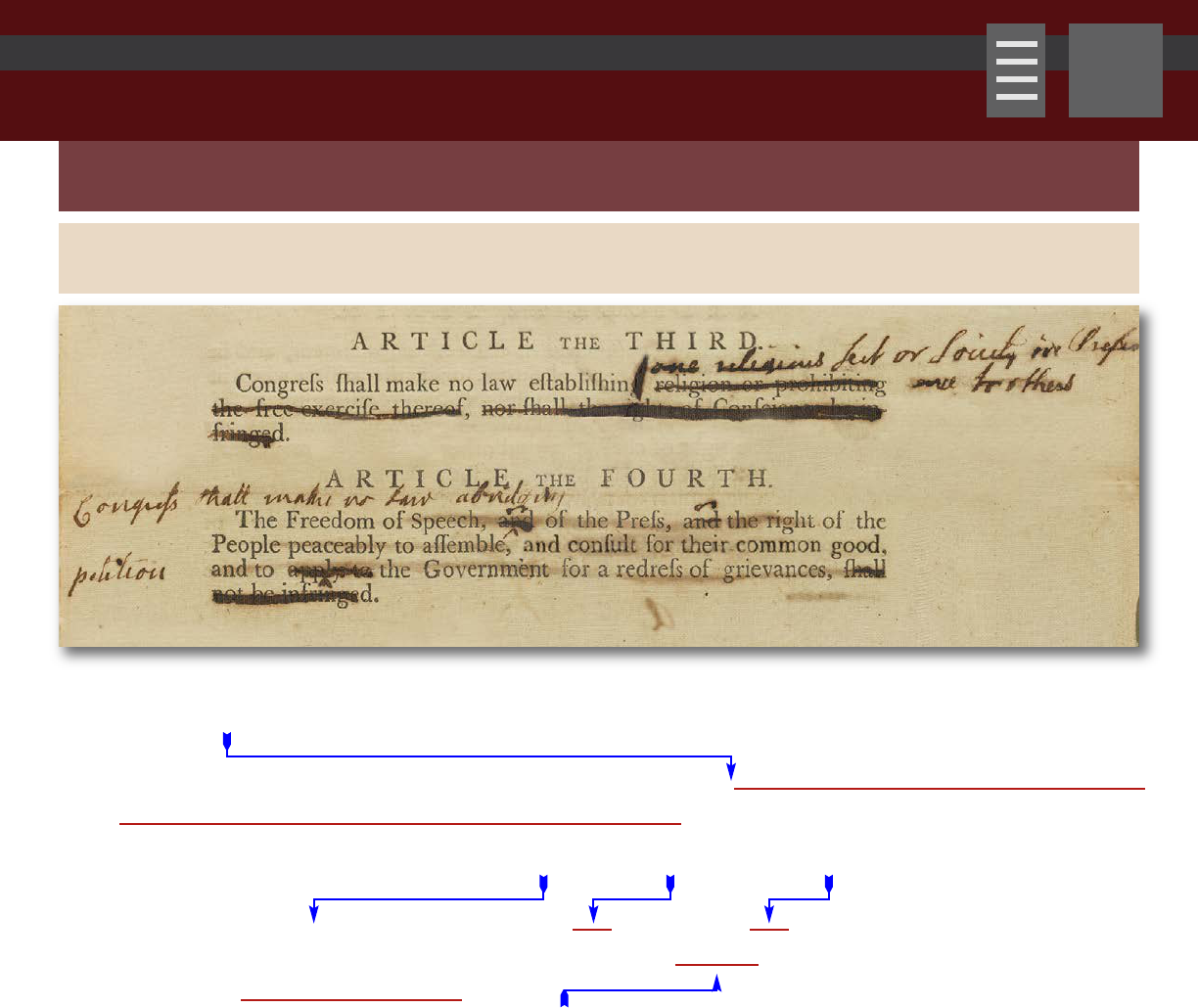
32
September 4, 1789
Senate Legislative Journal, September 4, 1789
Senate Revisions to the House Proposed Amendments to the U.S. Constitution, 1789.
RG 46: Records of the U.S. Senate, National Archives
“Article the Third. Congress shall make no law establishing religion, or prohibiting the free exercise
thereof, nor shall the rights of Conscience be infringed.
Article the Fourth. The Freedom of Speech, and of the Press, and the right of the People peaceably to
assemble, and consult for their common good, and to apply to the Government for redress of
grievances, shall not be infringed.”
Go Inside the First Congress
Congress shall make no law abridging or or
petition
one religious Sect or Society in Preference to others
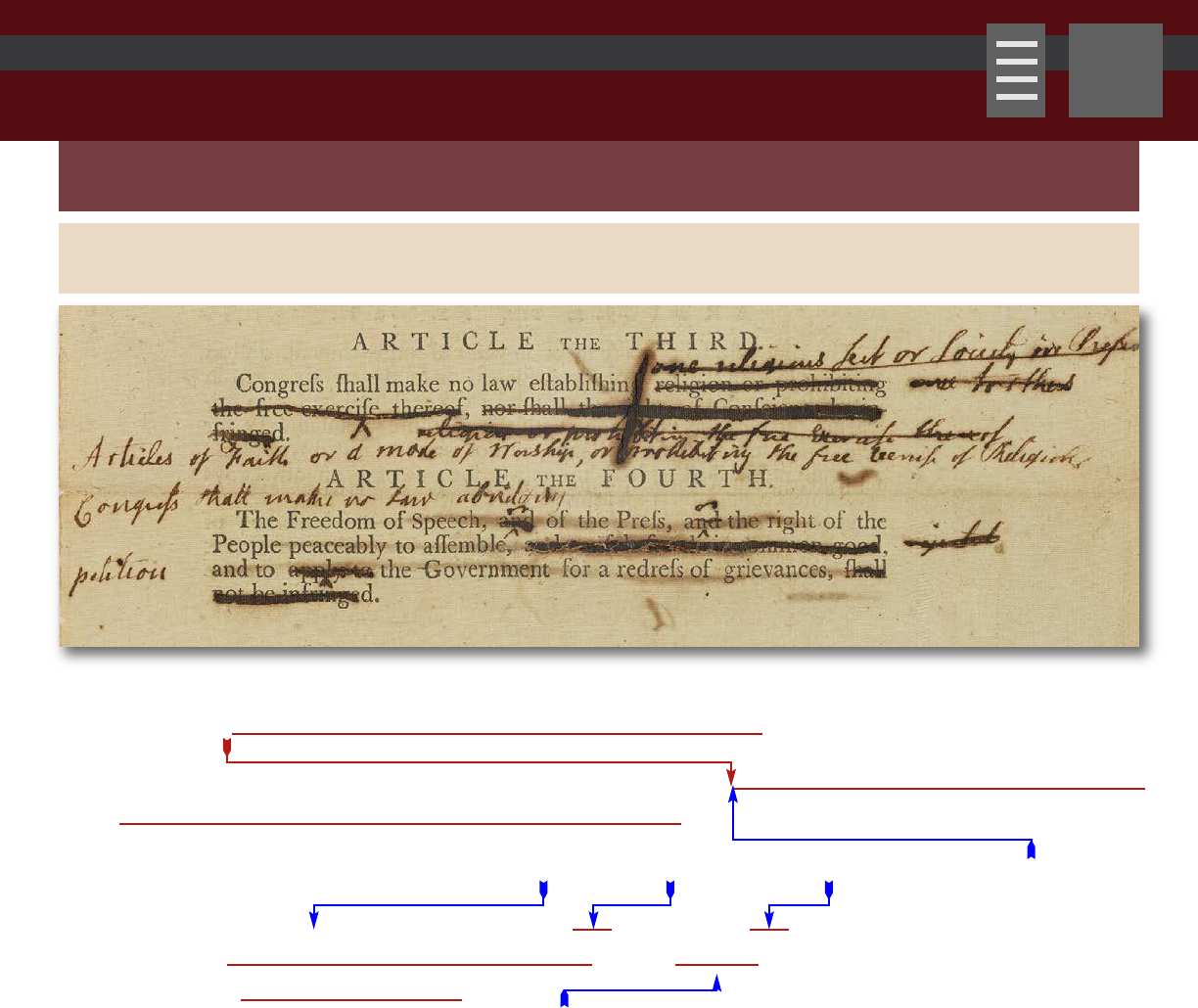
33
September 9, 1789
Senate Legislative Journal, September 9, 1789
“Article the Third. Congress shall make no law establishing religion, or prohibiting the free exercise
thereof, nor shall the rights of Conscience be infringed.
Article the Fourth. The Freedom of Speech, and of the Press, and the right of the People peaceably to
assemble, and consult for their common good, and to apply to the Government for redress of
grievances, shall not be infringed.”
Senate Revisions to the House Proposed Amendments to the U.S. Constitution, 1789.
RG 46: Records of the U.S. Senate, National Archives
Go Inside the First Congress
Congress shall make no law abridging or or
petition
one religious Sect or Society in Preference to others
Articles of Faith or a mode of Worship, or prohibiting the free exercise of Religion
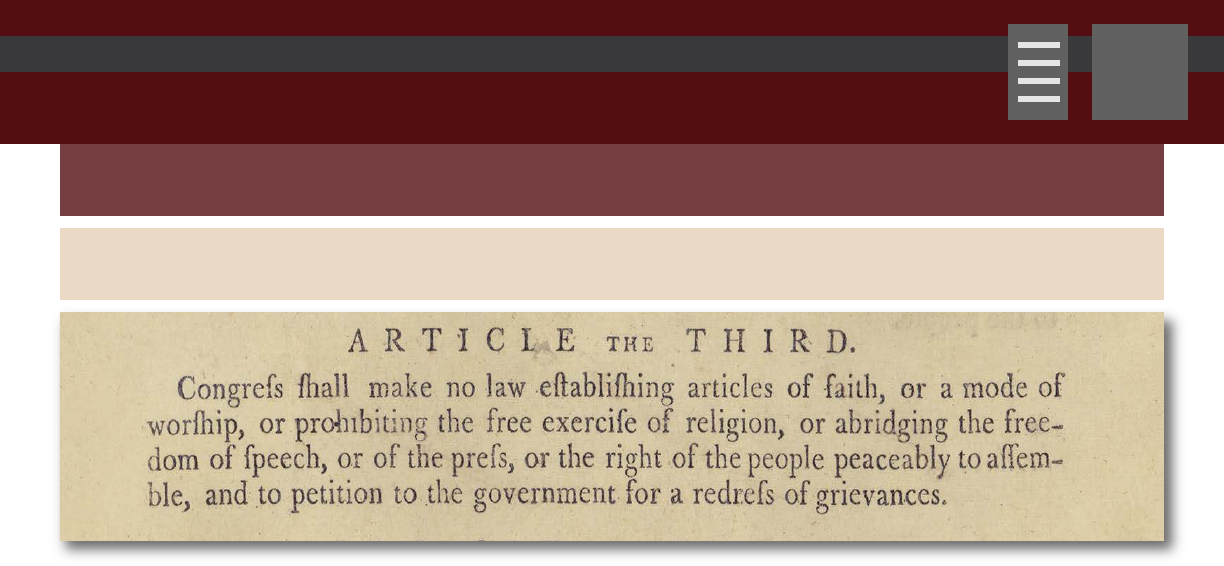
34
September 14, 1789
Senate Legislative Journal, September 14, 1789
“Article the Third. Congress shall make no law establishing articles of faith, or a mode of
worship, or prohibiting the free exercise of religion, or abridging the freedom of speech, or of
the press, or the right of the people peaceably to assemble, and to petition to the government
for a redress of grievances.”
Proposed Amendments to the U.S. Constitution as Passed by the Senate, 1789.
RG 46: Records of the U.S. Senate, National Archives
Go Inside the First Congress
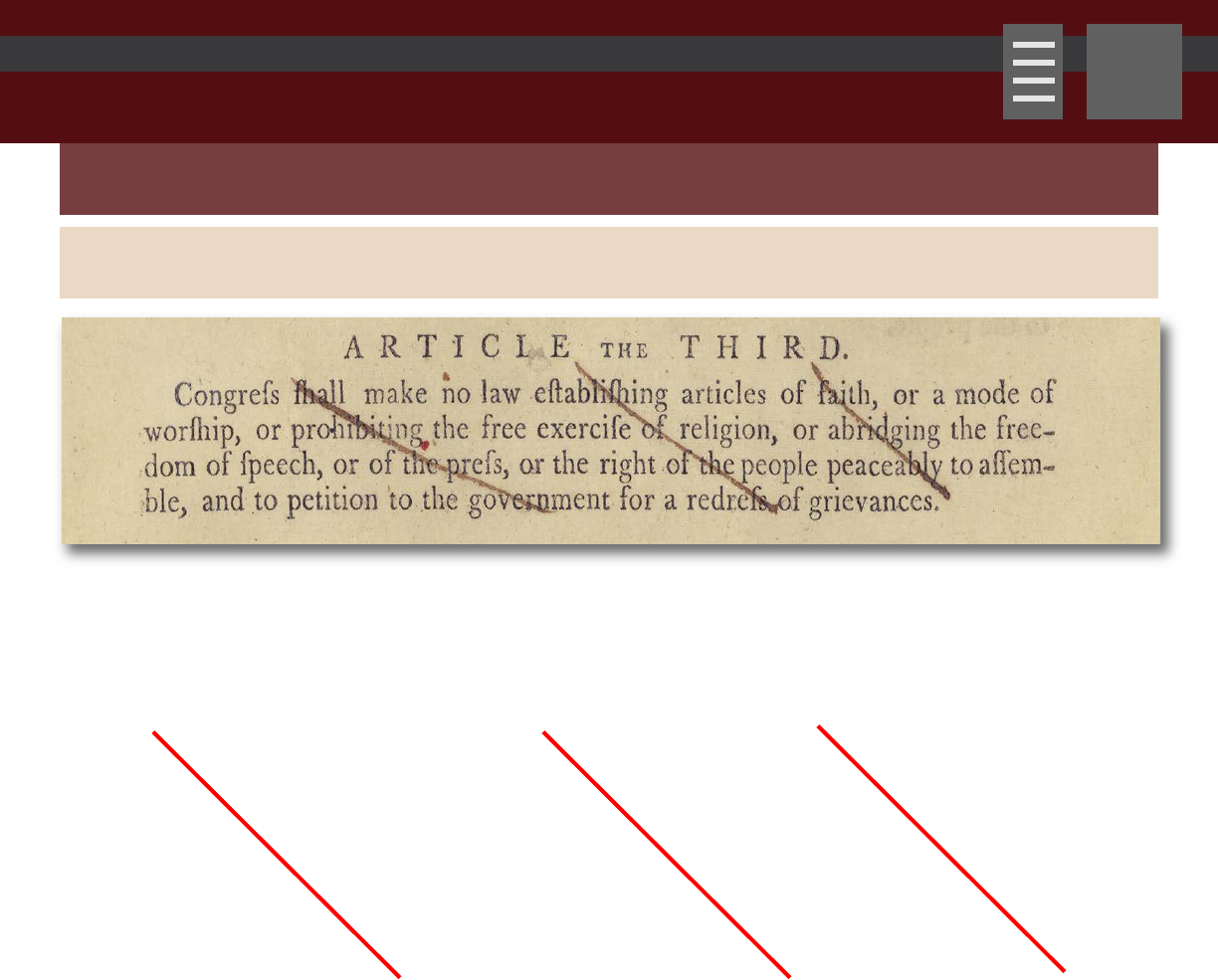
35
September 24, 1789
Conference Committee Report, September 24, 1789
“Article the Third. Congress shall make no law establishing articles of faith, or a mode of
worship, or prohibiting the free exercise of religion, or abridging the freedom of speech, or of
the press, or the right of the people peaceably to assemble, and to petition to the government
for a redress of grievances.”
Proposed Amendments to the U.S. Constitution as Passed by the Senate, 1789.
RG 46: Records of the U.S. Senate, National Archives
Go Inside the First Congress

36
October 2, 1789
October 2, 1789
“Art. 3. Congress shall make no law respecting an establishment of religion, or prohibiting
the free exercise thereof; or abridging the freedom of speech, or of the press, or the right of
the people peaceably to assemble, and petition the Government for a redress of grievances.”
Journal of the Senate of the United States of America, First Session of the First Congress, 1789–1793,
Volume 1; Washington; Gales & Seaton, 1820
Go Inside the First Congress

